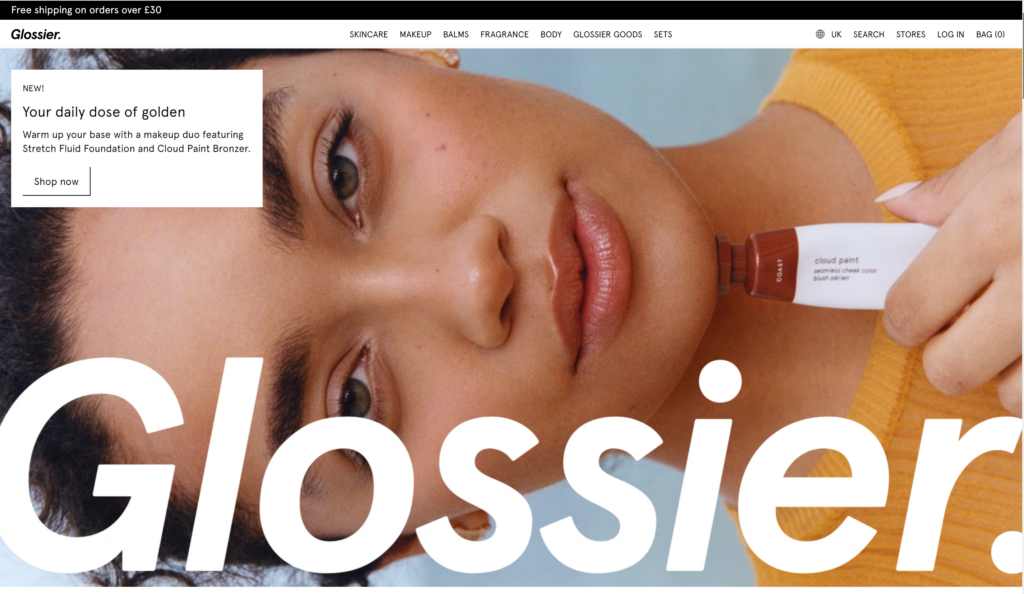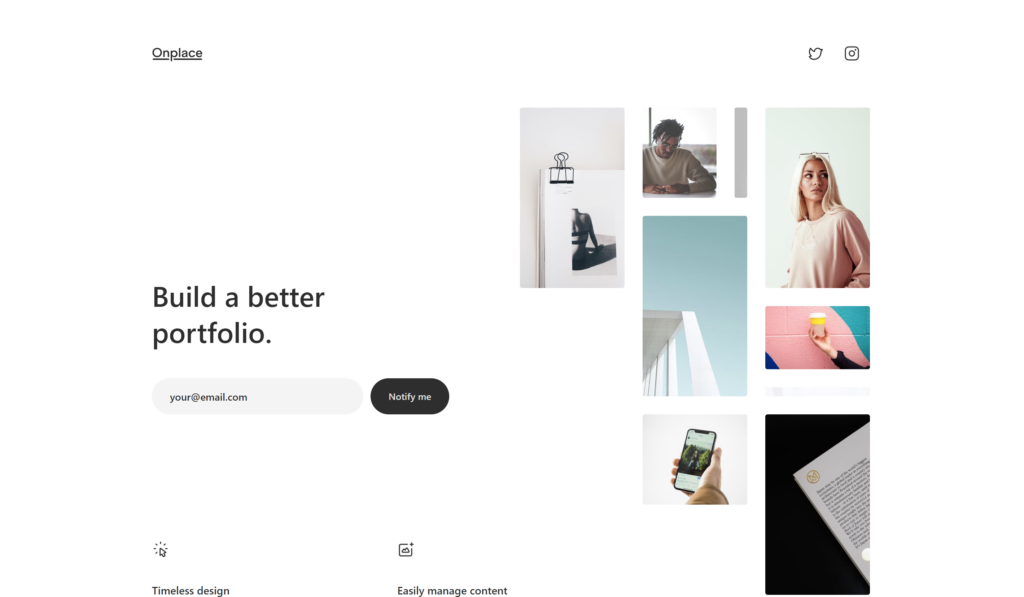want expert advice on your website? get in touch for a free website audit
book your free website audit
Minimalist web design has become popular in recent years, and it’s not hard to see why. Many brands are ditching the over-the-top designs that overwhelm users in favour of a sleek and clean look. These designs feel like a breath of fresh air and users are loving it.
This new design trend goes beyond just aesthetics. It’s also about getting rid of the unnecessary clutter to reveal the content that truly matters. This helps create websites that are not only visually appealing but also easy to navigate.
We all know the saying “Less is more” and minimalist web design helps you achieve just that. You get to have a website that is less in design but more in impact.
In this blog, I go into the key elements you’ll find in minimalist web designs as well pros and cons of going the minimalist route.
Key Elements of Minimalist Web Design:

- Clean layout: Minimalist websites heavily focus on a clean and spacious layout. You’ll notice lots of negative or white space to give your content some room to breathe. By reducing the visual noise, minimalist web design lets users dial into the content that matters without getting sidetracked. The trick here is to remain intentional about the way you use that negative space. Using too much can end up making your site appear plain and bare and using too little can cause you to miss the mark on minimalism.
- Simple typography: Another big part of minimalist web design is the use of simple typography. Many minimalist websites often use sans-serif fonts that are super easy on the eyes. The idea here is to make the content easy on the eyes on possible to reduce the chances of distractions.
- Limited colour palette: When it comes to colours, minimalist websites like to keep it clean with a limited palette. Think neutral or monochromatic tones that let the content take the spotlight. It’s all about creating a seamless, visually pleasing experience that’s easy to digest.
- Visual hierarchy: Without the use of flashy popups or eye-catching animations, minimalist designs instead rely on subtle visual cues like playing around with the size, colour, or fonts to guide the user’s eyes around the page. These design choices speak volumes without breaking the minimalist web design “rules”.
You may also like: How Web Design Influences User Behaviour!
Pros of Minimalist Web Design:

User Experience:
Minimalist web design focuses heavily on simplicity. It’s is all about cutting back and getting straight to the point. Instead of bombarding users with a bunch of unnecessary elements, you’re giving them exactly what they need. This helps to keep your site navigation as easy as possible. Plus, with fewer clickable distractions, your visitor’s eyes are naturally drawn to the important elements, like calls to action.
Users are also more likely to stick around as they’re less likely to become overwhelmed or confused in a maze of buttons or links. They have a clear path laid out right in front of them which can result in a more positive user experience and increased engagement.
Faster Loading Times:
As I mentioned above, minimalist websites are all about simplicity. And that simplicity isn’t just for show. It makes a huge difference in how fast your site loads and performs. With fewer elements to load, such as images, scripts, and plugins, users are no longer twiddling their thumbs waiting for your page to load. This helps cater to the growing demand for fast-loading websites, reducing bounce rates and increasing user retention.
Improved Brand Image:
A minimalist design is often associated with a sense of sophistication and professionalism. When your website looks polished, it’s bound to hook your audience and keep them coming back for more. Plus, sticking to minimalistic design elements keeps your brand image consistent and sleek.
More Focus on Content:
When brands opt for minimalism, content is king. By clearing away the visual noise, the words you put onto your site take centre stage. Whether it’s your brand story, product details, or blog posts, the minimalist design lets your message speak loud and clear, helping you build a deeper connection with your audience.
What’s more, is that with minimalist design, you’re not just saving space, you’re saving time too. Instead of getting caught up in tweaking every little detail on your site, you can invest that time in fine-tuning your content. This will help to build a strong brand identity and establish credibility with visitors.
Mobile-Friendly Design:
Minimalistic design principles and responsive web design go hand in hand. When you keep things simple and clean, it makes it easier for your website to adapt to smaller screens and resolutions.
This is great from an SEO perspective because many search engines have embraced a mobile-first approach and use it as a key ranking factor. By adopting a mobile-friendly design, you increase your chances of ranking high on search engine result pages (SERPs). It’s like hitting two birds with one stone – making users happy and climbing up the SEO ladder at the same time!
Cons of Minimalist Web Design:
Risk of Oversimplicity:
When it comes to minimalist web design, there’s a fine line between minimalism and oversimplification. This is why it is important to find the sweet spot where your website looks clean and uncluttered, yet still provides all the vital information and features.
If you end up falling into the trap of oversimplification, you run the risk of poor user experience. Users will struggle to find the content they’re looking for, which will inevitably lead to them leaving your website.
The key to minimalist web design is to create a user experience that’s both appealing and functional, where simplicity and usability go hand in hand. When it’s done right, you’ve got a website that not only looks great but also keeps visitors hooked and coming back for more.
Harder to Stand Out:
With more and more minimalist websites popping up, it can be a real challenge to set your brand apart from competitors. Without unique visual elements or design choices, minimalist websites run the risk of blending in with the crowd. This makes it hard for visitors to spot your brand from the sea of others and fail to connect with what makes you special.
And it doesn’t help that these simple websites are everywhere these days. From the clean layout to the ease of use, these designs end up being the default for many websites. However, with a lack of creativity, users get bored, they lose interest, and suddenly, your brand’s not a talking point anymore.
To avoid these challenges, you need to be deliberate about your design choices. Choose features that align with your brand’s unique identity such as bespoke bespoke typography, custom illustrations, or a signature colour palette. Don’t forget to work on delivering your message through killer content. That’s what’ll stick with users and avoid leaving your website looking generic.
Lack of Creative Freedom:
While minimalist design does offer that sleek and sophisticated look, when working with these sorts of websites you’re often faced with the challenge of limited creative expression. When working with these sorts of websites, many designers feel like they’re working within a tight box with no space for creativity. You may want to experiment with some vibrant colours or cool layouts, but minimalism puts constraints on that and holds you back.
For designers who thrive on pushing boundaries and trying new things, this can feel confining. It tends to suck the life out of designs with the rigid framework minimalism has in place. And when everyone’s following the same guidelines. things can start to look and feel the same. Your design might start to blend in with the rest.
When adopting a minimalist approach, it’s important to remember that you won’t have the same freedom to explore or innovate. This is a huge concern if your competitors are, leaving you behind the curve.
Not Suitable for all Industries:
A major setback with minimalist web design is that it’s not suitable for all industries. Take gaming or entertainment, for example. Those industries are built around creative flair and minimalist websites just don’t pack the punch needed to create that “wow” factor.
This is why if your audience craves something new and exciting, you need a design that matches that energy. Think vibrant colours, bold graphics, and interactive elements that fit the overall bill of the industry.
It’s important to know that minimalism is not a one-size-fits-all solution. Sure, it works wonders for some, but for others, exploring alternate routes can work in your favour. Before diving headfirst into the minimalist web design rabbit hole, take a step back and really think about whether it’s the right move for you. Identify your goals and consider whether they align with your specific needs and objectives. You should also conduct some competitor and target audience research to find out what sorts of designs would be a right fit.
You may also like: Simple vs Complex Web Design!
Closing thoughts:
Minimalist web design not only offers numerous benefits in terms of user experience, performance, and improved brand image, but it’s also easy to implement. The key elements required for these types of websites can be added to any site in no time.
However, it is essential to be mindful of the potential pitfalls of these simple design choices. The lack of creative freedom combined with the fact that it’s harder to stand out from the competition can do more harm than good.
To build a killer website you need to understand your audience and the context of your site. You should also keep in mind that customer behaviour and search algorithms are always changing. That’s why you need a site that’s flexible enough to handle whatever industry changes you throw at it.
At the end of the day, it’s all about finding the right balance between looks and functionality. Sure, minimalist design has its perks, but it’s not the holy grail for every business out there. Designers and businesses need to think about what works best for their industry and their audience. Sometimes, that means stepping outside the minimalist box and exploring other design avenues that truly speak to your industry and audience.
